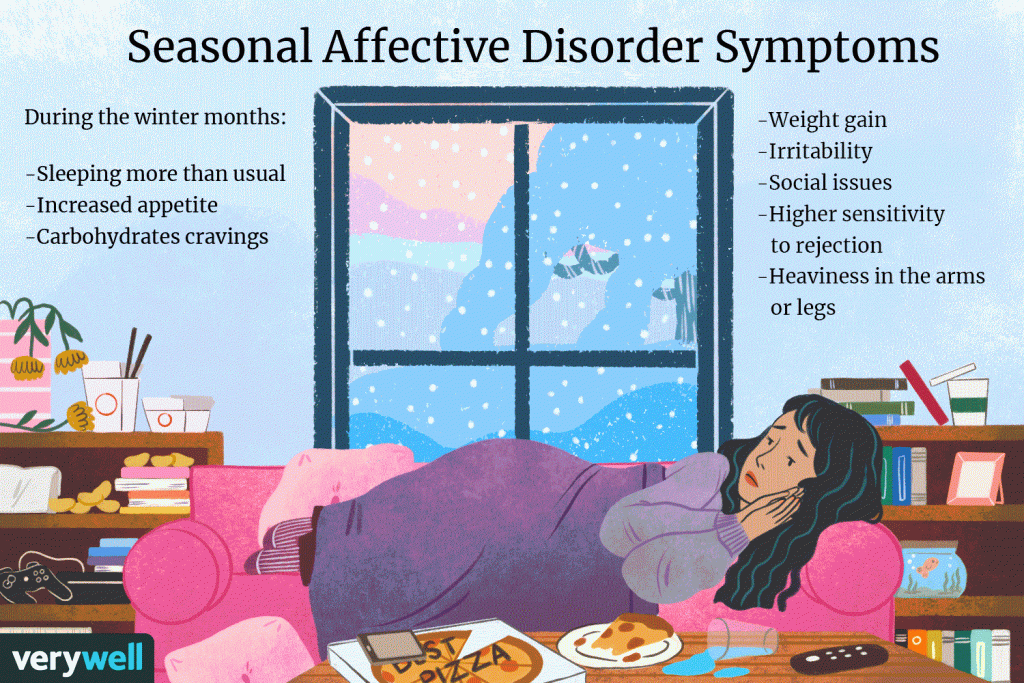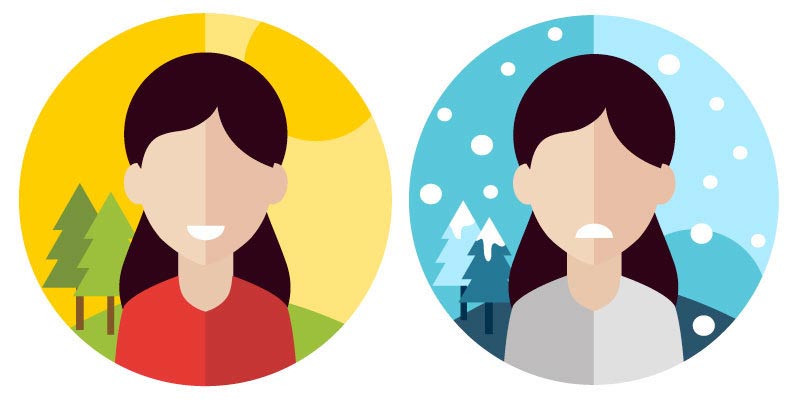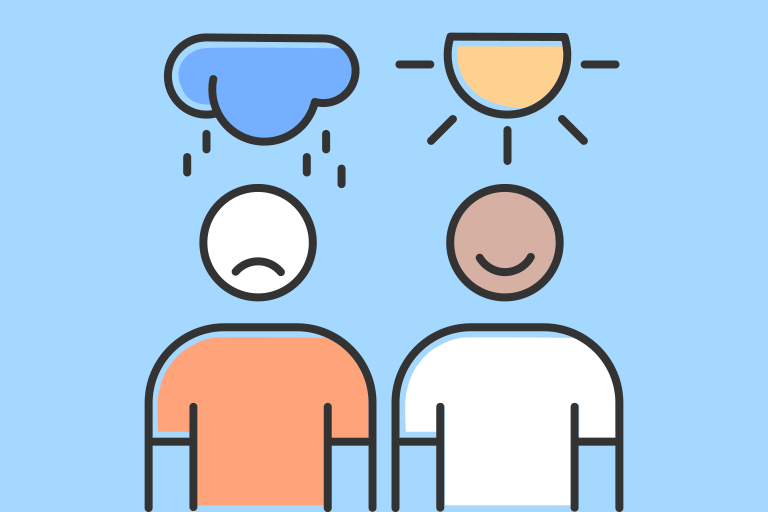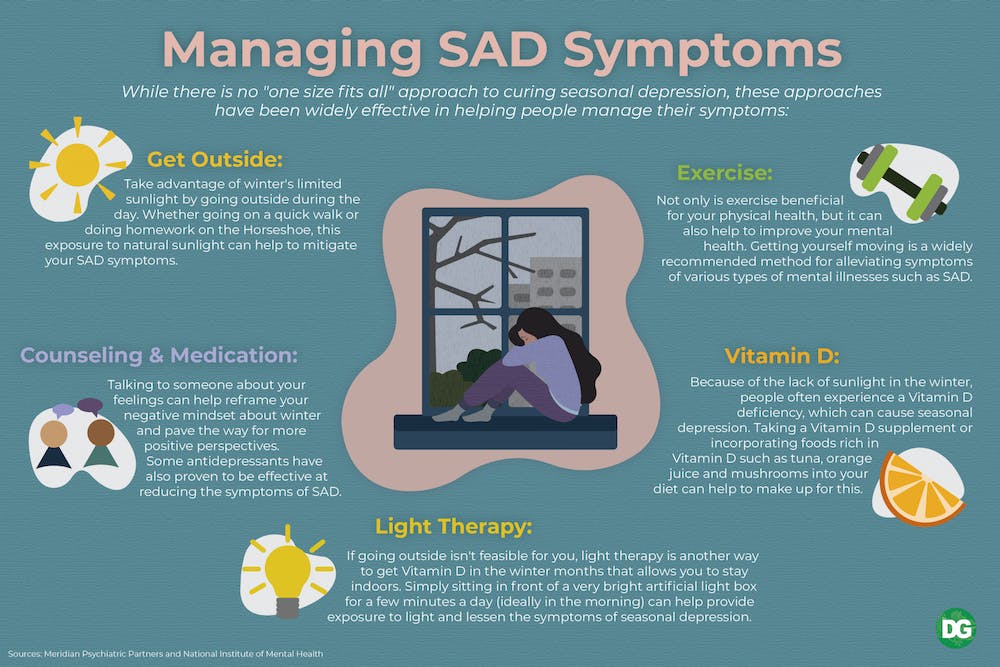
“Change isn’t easy, regardless of what time of year it is, but the shift into the winter months can be particularly harsh. We cling to consistency, especially when it comes to our personal strategies for mental health.
Unfortunately, as seasons change, choice is taken out of our hands. For disabled people, that shift can have additional psychological impacts.” [1]
One common concern during the winter months is seasonal affective disorder, or SAD.
“Seasonal Affective Disorder (SAD) is a type of depression that is exacerbated by gray overcast skies and poor indoor lighting.

Symptoms and Diagnosis
“Common symptoms of SAD include fatigue, even with too much sleep, and weight gain associated with overeating and carbohydrate cravings. SAD symptoms can vary from mild to severe and can include many symptoms similar to major depression, such as:
- Feeling sad or having a depressed mood
- Loss of interest or pleasure in activities once enjoyed
- Changes in appetite; usually eating more, craving carbohydrates
- Change in sleep; usually sleeping too much
- Loss of energy or increased fatigue despite increased sleep hours
- Increase in purposeless physical activity (e.g., inability to sit still, pacing, handwringing) or slowed movements or speech (these actions must be severe enough to be observable to others)
- Feeling worthless or guilty
- Difficulty thinking, concentrating, or making decisions
- Thoughts of death or suicide;
SAD may begin at any age, but it typically starts when a person is between ages 18 and 30.” [3]

Seasonal Affective Disorder (SAD) and the Americans with Disabilities Act
“The ADA does not contain a definitive list of medical conditions that constitute disabilities. Instead, the ADA defines a person with a disability as someone who (1) has a physical or mental impairment that substantially limits one or more “major life activities,” (2) has a record of such an impairment, or (3) is regarded as having such an impairment. For more information about how to determine whether a person has a disability under the ADA ( see How to Determine Whether a Person Has a Disability under the Americans with Disabilities Act Amendments Act (ADAAA).” [2]

SAD in disabled individuals
“For individuals with disabilities, SAD can be especially challenging. Mobility aids can be dangerous to use in winter conditions, the risk of airborne and seasonal illness intensifies and some types of chronic pain increase in cold weather. Similarly to older individuals, the change and season can lead to increased social isolation.
Mental conditions, such as SAD, are also more common in people who are already dealing with other ongoing medical conditions. The Centers for Disease Control and Prevention reports that adults with disabilities report experiencing frequent mental distress almost five times as often as adults without disabilities. People struggling with mental health are more prone to low motivation, not seeing their doctors when they need and having difficulty managing their disability.” [4]
- “Make a habit of getting out for a daily walk. This helps your mood by breathing in fresh air and providing a change in scenery, all while exercising.
- Add vitamin D into your diet and nutritional changes. Consult with a nutritionist or physician on what kinds of things you should target in your diet or what you should increase.” [4]
- Eat a balanced diet: Nutritious foods help promote positive well-being. Ensure you are incorporating healthy foods into your diet and continue to take any prescribed medications on schedule.
- “Get social with friends and family. This helps stimulate your mind and mood by being around others.
- Move your body with physical activity. It doesn’t have to be hard exercise, but moving your body will provide physical stimulation.
- Reach out to your support network. Tell your family and friends how this change of season affects you so they can check in on you. They can also help hold you accountable to your commitments and support you.” [5]

“Whether you are a disabled individual (or know a disable people), or merely feeling the effects of the changing season, it is vital to monitor your mental health. Seasonal Affective Disorder is a real issue that can be prevented and treated. If you think you may be suffering from SAD, you don’t have to go through it alone – seek advice from medical professionals who can ensure proper treatment.” [4]
Resources
[1] https://www.verywellmind.com/disabled-people-face-barriers-as-seasons-shift-6833519
[2] https://askjan.org/disabilities/Seasonal-Affective-Disorder-SAD.cfm
[3] https://www.psychiatry.org/patients-families/seasonal-affective-disorder
[4] https://www.maximhealthcare.com/healthcare-blog/seasonal-affective-disorder/
